Bran Sands Gas to Grid Project (2020)
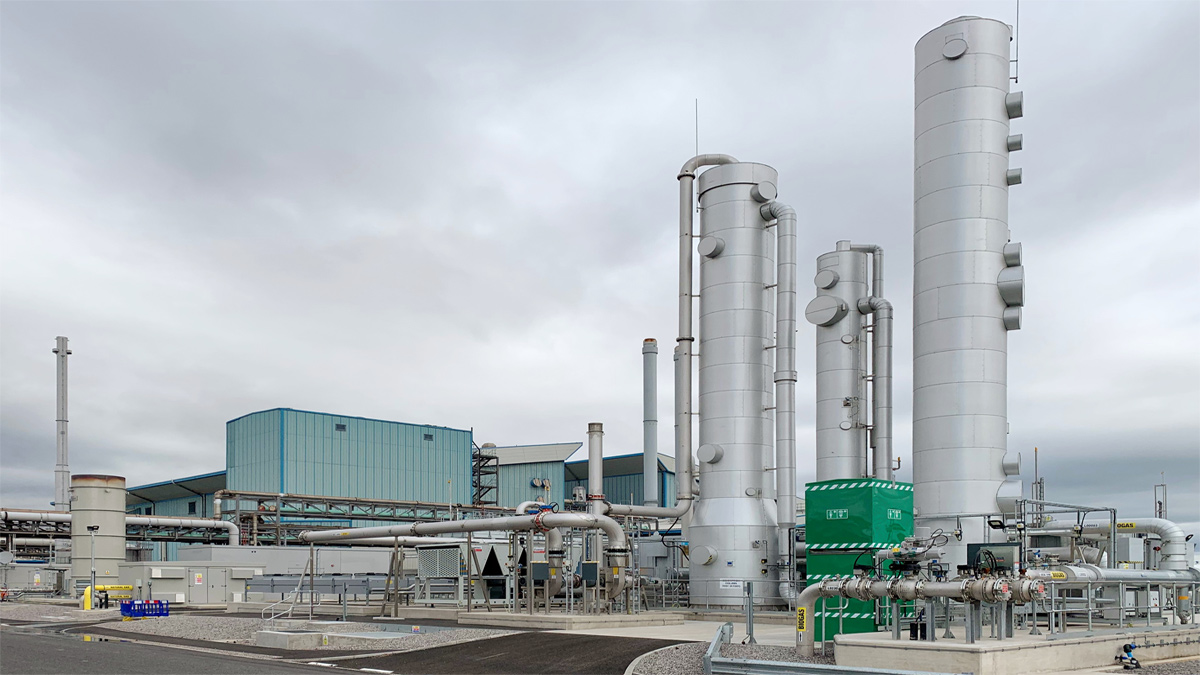
Bran Sands Gas to Grid Project - Courtesy of Northumbrian Water Group
Northumbrian Water Group (NWG) have two sludge treatments centres, at Bran Sands STW on Teesside and at Howdon STW on Tyneside, which together process 100% of the sewage sludge arising from within its operating region, using an advanced anaerobic digestion (AAD) process. The resultant renewable biogas is converted into biomethane for export to grid. The gas to grid plant at Bran Sands was constructed during 2019 and has been in daily operation since 23 January 2020.
Brans Sands STW and Sludge Treatment Centre
Bran Sands STW, located on the south bank of the estuarial River Tees at Teesport, 5km to the east of Middlesbrough, was developed as a new site in the 1990s to treat industrial effluents predominantly from the Wilton and Seal Sands Industrial estates, along with municipal wastewater from the population of Teesside. The site is surrounded by private land, either used for heavy industrial processes or used for port facilities, and as such all site utility services are provided under private agreements, with the nearest public gas distribution network (GDN) over 5km away.
The sludge treatment centre is capable of treating up to 40,000 tonnes dry solids/annum of indigenous and imported sludges via a thermal hydrolysis AAD plant which was commissioned in 2009. Biogas produced in the digestion process is supplied to 4 (No.) Jenbacher CHP engines with a total installed electrical output of 4.7MW for power generation and income from Renewable Obligation Certificates. Waste heat from the engine exhausts is recovered and used in steam generators to complement the boiler raised steam needed for the AAD process.
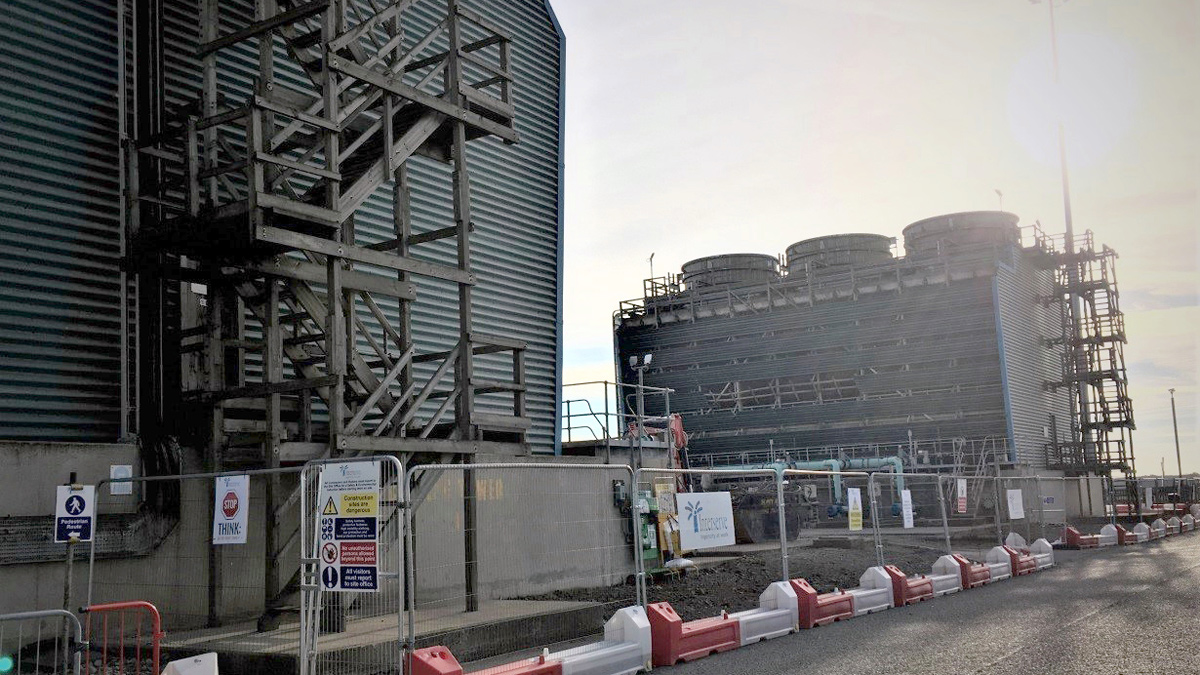
Bran Sands cooling towers prior to demolition – Courtesy of Interserve Construction
Renewable Heat Incentive scheme
The UK Government’s Renewable Heat Incentive scheme became live in 2013 with the goal of greening the UK’s heat network, by encouraging developments using a tariff support mechanism. This was initially successful, with NWG choosing to develop and commissioning a gas to grid plant at Howdon STW which has operated successfully since late 2014.
The Howdon Biogas Upgrading Project was featured in UK Water Projects 2016.
NWG had aspirations to develop a similar gas to grid plant at Bran Sands at this time, but due to its location and the uncertain timescales for the provision of a gas supply to site, the project was shelved in 2015, against a background of declining RHI tariffs.
In 2017 the UK Government announced that the Renewable Heat Incentive scheme was to be refreshed and would include a tariff guarantee (TG) for eligible sites; for NWG this would mitigate in part the time risk associated with bringing the necessary gas pipeline to Bran Sands STW. The refreshed RHI scheme did not pass onto the statute book until May 2018, with a TG eventually being secured by NWG in October 2018. Despite the government delays, the TG end date remained at 31 January 2020 which meant the project would need to be delivered within 15 months.
Project delivery
Given the short timescale in which to complete the development, it was necessary to adopt many aspects of the gas to grid plant constructed at Howdon in 2014 as the basis of design of the new Bran Sands plant, and also to build upon the lessons learnt from the delivery of that project.
The following contracts needed to be let as quickly as possible to ensure that the TG date was achieved:
- Natural gas pipeline extension.
- Biogas upgrading plant (BUP).
- Propane storage and transfer plant.
- Grid entry unit (GEU).
- Technical support.
- site infrastructure package to connect the main process plants and to integrate the overall gas to grid plant within the existing site infrastructure).
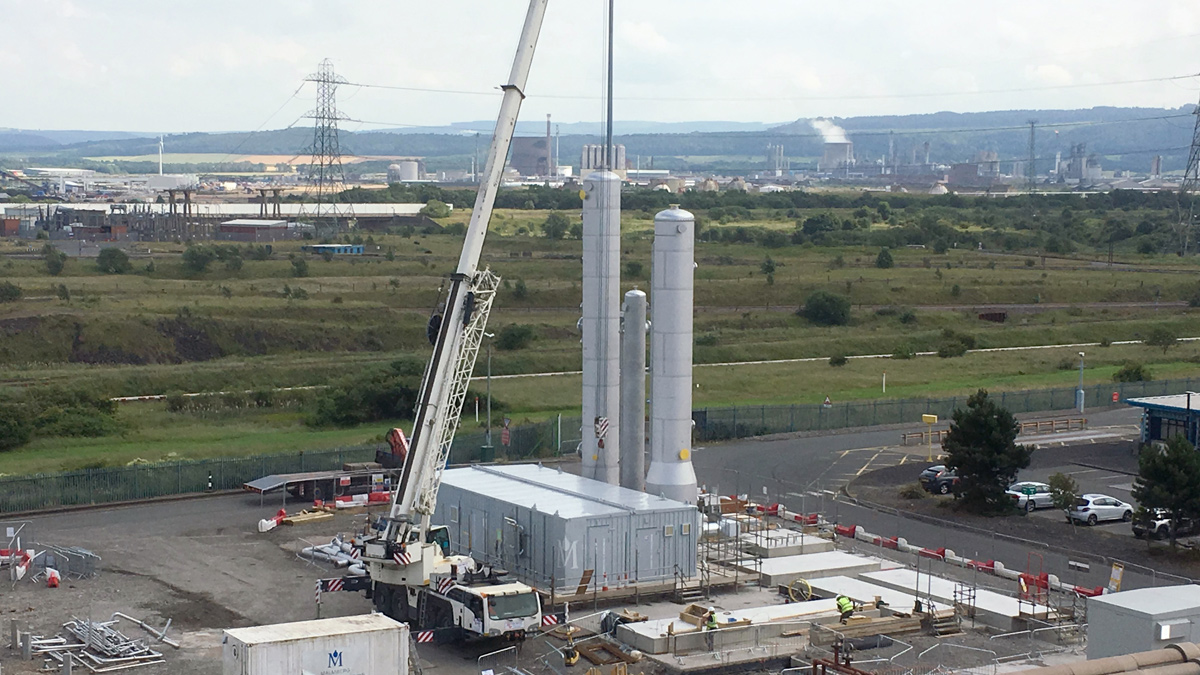
Biogas upgrading plant column installation – Courtesy of Interserve Construction
To connect Bran Sands STW to the local GDN, a 5km long 2 bar gas supply pipeline was required, 2km of which had to be laid in land privately held by Sembcorp and others; this section of the pipeline was subject to a number of agreements with existing pipeline service operators. The new gas pipeline also needed to cross two high pressure gas pipelines carrying North Sea gas from Redcar to the Teesside gas processing plants at Seal Sands.
The gas supply pipeline was identified as the riskiest aspect of the project delivery in terms of timescale and as a result work had commenced with Northern Gas Networks (NGN) in late 2017 to identify a corridor and develop a suitable design. The task was made more difficult by the complex land ownership agreements, which were in a period of change following closure of the adjacent steelworks and the acquisition of former ICI land by Sirius Minerals, the developers of the large scale polyhalite fertiliser project.
Once land acquisitions were completed, NGN were able to progress the scheme and a series of stakeholder meetings were held to identify constraints and develop common solutions. The agreements to lay the pipe took a significant sustained effort and were not completed until October 2019; leaving less than 2 months to complete construction of the private section of the pipeline. NGN mobilised appropriately for the time that remained and managed to bring the supply pipeline through to site on 17 December 2019; the whole process having taken 2 years in total.
The AAD process at Bran Sands produces biogas that typically contains 61% methane with the remainder comprising carbon dioxide (CO2) and trace amounts of nitrogen, oxygen, hydrogen sulphide, and siloxanes. The standard for gas injected into the GDN is defined by the Gas Safety (& Management) Regulations (GSMR), and additionally in the case of biogas derived from wastes such as sewage sludge, the Environment Agency’s End of Waste Protocol.
In order to meet the applicable standards, CO2, and other unwanted components must be removed, to leave a methane content greater than 95%. An important lesson learned from the Howdon project is that gas in the GDN in the North East of England very often has a higher calorific value (CV) compared to other parts of the country, and it is desirable to leave 1-2% of CO2 by volume in the biomethane to control GSMR parameters such as Wobbe Index and Incomplete Combustion Factor. Water scrubbing biomethane upgrade plants are more suited to this kind of operation than for instance chemical wash or membrane upgrade plants, which make a very pure biomethane containing over 99% methane thus making it more difficult to inject into grid at high target CVs.
Malmberg Water were selected to provide the main water scrubbing biogas upgrading plant (BUP), of the same type and biogas processing capacity previously proven at Howdon STW. The commonality of approach yielded efficiencies in training, spares and maintenance and also a high level of confidence in plant performance and delivery timescales. The BUP was sized for a biogas flow of 1,900m3/hr.
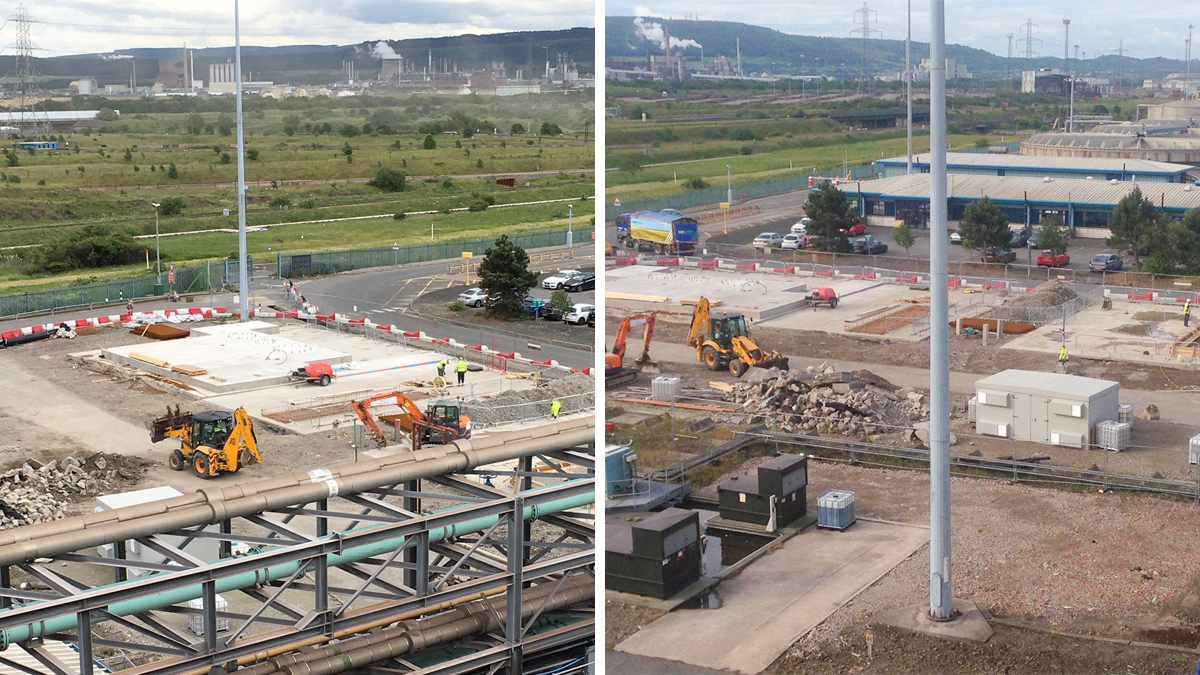
Biogas upgrading plant (BUP) slab construction – Courtesy of Interserve Construction
Regardless of the upgrade technology, every plant needs to have some propane added to meet the declared target CV of the GDN, and the technology selected for vaporising propane determines how much electrical energy needs to be deducted from the eventual RHI claims.
After a tender phase, Flogas were awarded the contract for supply and installation of the complete propane storage and transfer plant and also for the bulk propane supply. Two 12 tonne propane storage tanks were required together with transfer pumps capable of delivering up to 120 kg/hour. Once again, confidence in the quality of the equipment and their delivery plan based on NWG’s experience of working with Flogas at Howdon STW was a significant factor in their selection.
The enriched biomethane then passes through the grid entry unit (GEU), where all process parameters are checked using a gas chromatograph before injection. Gas quality information is continually transmitted to Northern Gas Networks (NGN) via satellite telemetry. Final entry to the grid system is through a remotely operated valve under the control of NGN, this will close if any one of the gas quality parameters is not met stopping flow to the GDN. Sampling is also carried out in the GEU upstream of the gas chromatograph and enriched biomethane which is out of specification on the parameters being analysed is diverted to the reject gas flare and burnt until the specification is met.
For the GEU, an assessment of potential suppliers was made in advance of the tariff guarantee being secured. Thyson Technology were selected based on the quality of the GEU and their ability to deliver in the required time period. The GEU unit was sized for a total flow to grid of 1,240m3/hr.
To help mitigate the time risks NWG directly procured all the process plant in its standard form under design and construction contracts. These contracts were let in the period between November 2018 and March 2019.
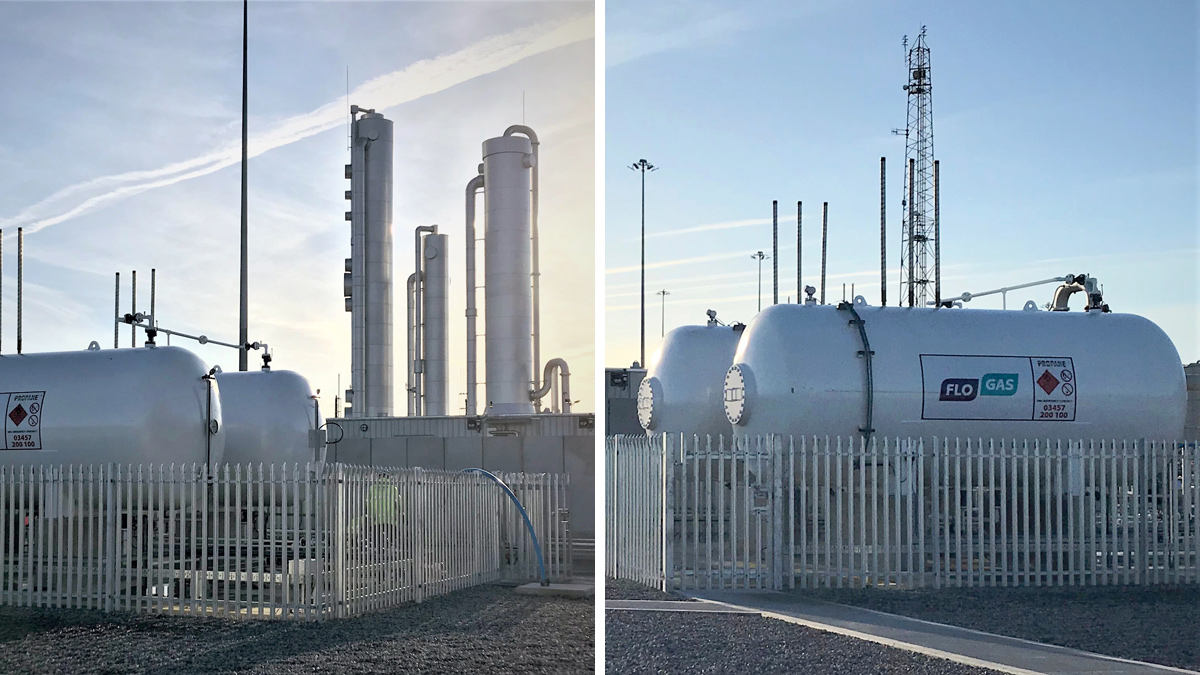
(left) The biomethane upgrade plant and (right) the propane storage area – Courtesy of NWG
There was a time and cost benefit of accepting each process package with the manufacturer’s standard control system, and to overcome potential control and communication issues, an interface PLC was installed which, in addition to controlling and monitoring the overall plant, collected data from the individual plant packages and retransmitted it to the site SCADA system. Each package plant will be maintained by the relevant supplier, so accepting the standard design will pay off in simplified maintenance arrangements over the long term.
Bran Sands Gas to Grid: Supply chain – key participants
- Technical support: Wood Group
- Gas supply pipeline (off–site): Northern Gas Networks
- Cost Consultants: Turner and Townsend
- Biomethane upgrade plant: Malmberg Water
- Site infrastructure: Interserve Construction Ltd
- Designers to Interserve: Wood Group
- Grid entry unit: Thyson Technology
- Propane storage & transfer: Flogas Britain
- Systems integration: IDEC
- Electrical: Intelect UK
- Civil engineering: Meldrum Construction
- Piling: Aarsleff Ground Engineering
- On site gas pipelines: Powerrun Pipe-Mech Ltd
- Reject gas flare: Uniflare
- Off gas chimney: Horizon Specialist Contracting
- HV transformer, switchgear & connection into site HV ring main: Integrated Utility Services
- Conversion of 3 (No.) Jenbacher CHP Engines to dual fuel operation: Clarke Energy
- Conversion of boilers to dual fuel operation: Eurograde Ltd
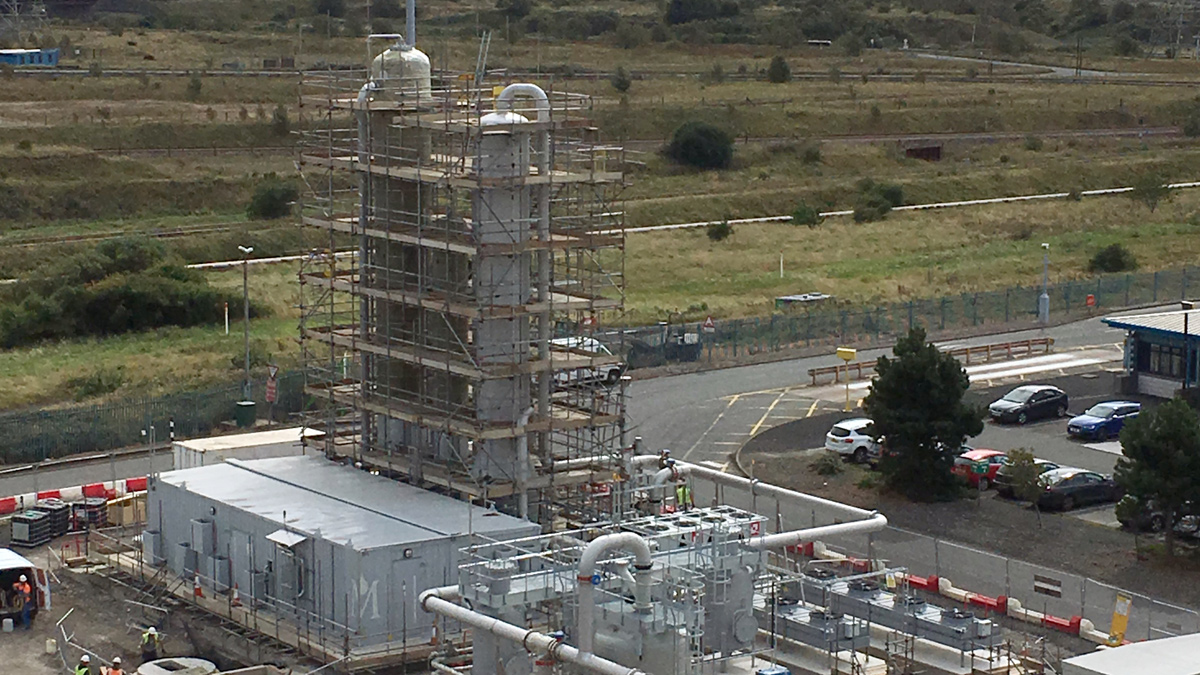
BUP column cladding – Courtesy of Interserve Construction
Procurement
The technical support contract awarded to Wood Group included the following activities:
- Outline design and programme support.
- Grid facing approvals (NGN G17 process).
- Environmental permitting variation.
- Overview training.
- RHI accreditation support.
- Package plant contract technical support.
For the supporting infrastructure needed to tie the process elements together, Interserve Construction Ltd. (ICL) were selected from NWG’s framework suppliers. In the light of the vital importance of the delivery date an NEC Option E Design and Construction contract was awarded, with Interserve taking the role of principal designer and principal contractor under the Construction Design and Management Regulations. ICL were responsible for coordination of the designs being prepared by the directly procured process contractors, integration of the suppliers’ construction programmes, and management and coordination of the construction site. Interserve’s design was prepared by Wood Group, who also fulfilled the principal designer role on behalf of ICL. Cost consultant services were provided by Turner and Townsend using the same ECC PM who had worked on the Howdon project.
Design and construction
NWG works in a collaborative fashion with its frameworks suppliers and the methodologies of the Construction Lean Improvement Programme (CLIP) were adopted for this project, to protect the delivery programme and to elevate the focus on supplier and sub-contractor delivery milestones and critical handover activities. The CLIP process was repeated monthly at first, moving to twice monthly as delivery and construction momentum built up.
A key part of the success of the CLIP approach was the integration within the project delivery team of two experienced process technicians from the operational site team who were able to direct and improve the operability of what was being delivered to them. Another successful aspect was the ability for these team members to interact with the suppliers who would later provide operator training and maintenance support.
The on-site plant passed through a conventional design process with Hazop, and Hazcon phases and regular design reviews. The most challenging aspects were integrating the plant into the existing site control and emergency shut down arrangements, and also providing supplier remote support to the process plants whilst complying with NWG’s security policies, which have tightened in response to the NIS (Network and Information Systems) Regulations.
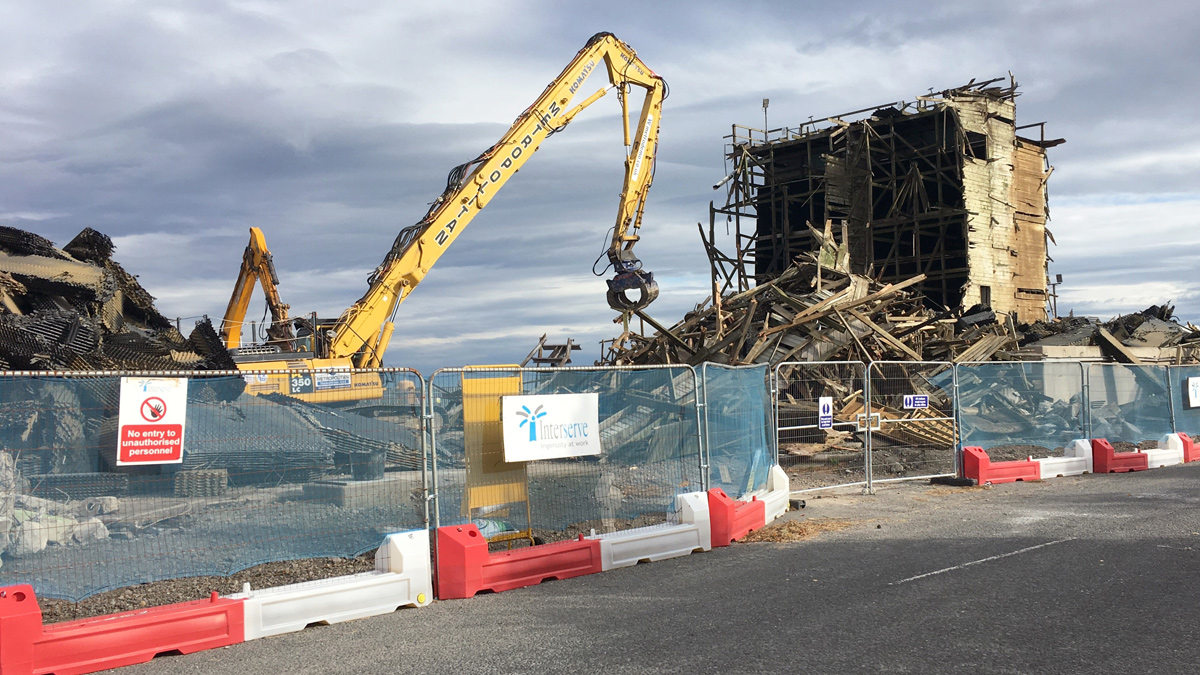
Bran Sands cooling tower demolition – Courtesy of Interserve Construction
The site allocated for the biomethane plant was occupied by two pairs of redundant cooling towers, sitting on a piled slab of sufficient size to be reused after modification. Demolition of the cooling towers commenced ahead of the tariff guarantee being secured, and was completed by the end of 2018. The design of the necessary plinths and landings for the BUP and GEU was done in collaboration with Malmberg Water and Thyson Technology. The civil engineering subcontractor provided a highly accurate finished slab, allowing Malmberg to erect their process columns without any adjustments being needed; a first in the biomethane plant suppliers’ experience. The propane storage area was designed based on a Flogas standard layout.
The biomethane plant was delivered to site in July 2019 as an exceptional load, using specialist haulage and contract craneage. Fortunately, the risk of import issues relating to Brexit were not encountered, but contract clauses had been drafted to deal with the possible eventualities.
The remaining process plant and equipment arrived in July and August, and Interserve’s integration works were sufficiently advanced to allow hot commissioning to commence in October 2019.
Hot commissioning of the gas to grid plant was completed by mid-November before construction of the natural gas supply pipeline was finished on 17 December, and it was possible to pass the first gas to grid on 19 December 2019.
In all, over 100,000 man-hours were worked on site with no lost time or reportable incidents.
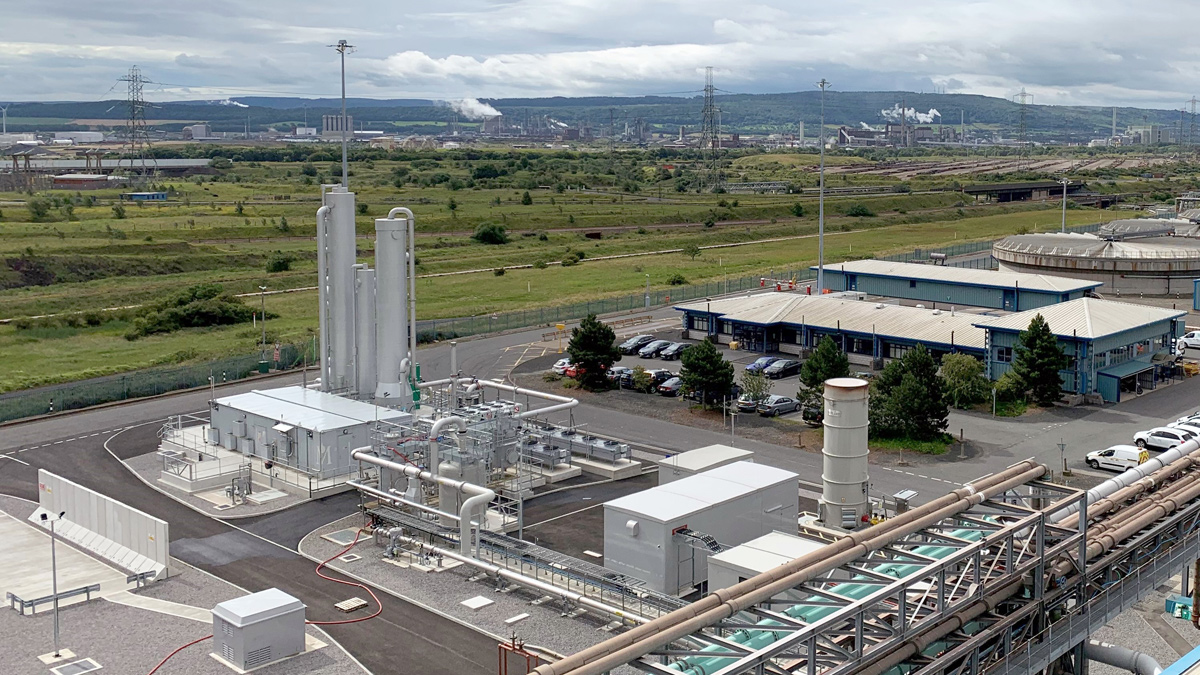
Completed gas to grid plant – Courtesy of Interserve Construction
Conclusion
Following completion of some outstanding works in the New Year, daily operations commenced on 23 January, with the plant attaining 94% availability since, and well on course to meet the expected annual injection total of 62,500 MWh, enough to supply the heating needs of around 4,000 homes.
Conversion of the CHP engines and steam boilers to dual fuel operation (natural gas/biogas) in early 2020 has allowed 100% of the biogas produced on site to be converted to biomethane. Coupled with the output from Howdon STW, this makes NWG the first water and sewage company to have the ability to export biomethane from 100% of its sludge bio-resources.





